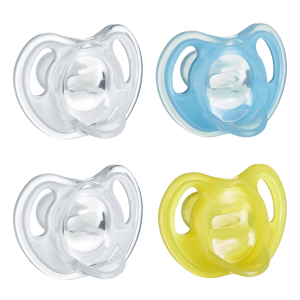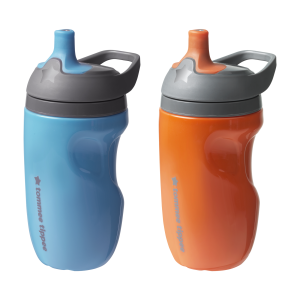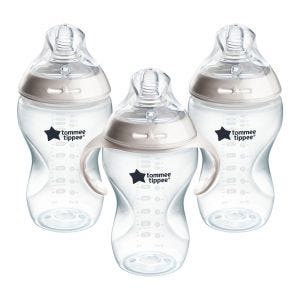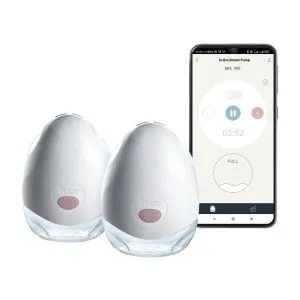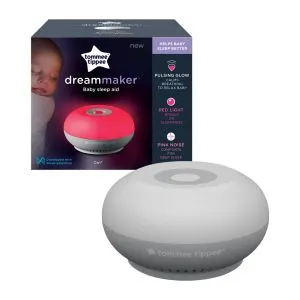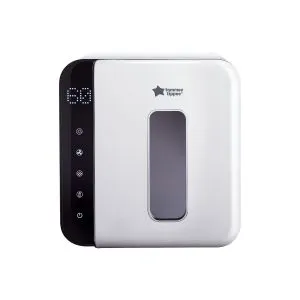
Tommee Tipps
Here's a handy ‘asked and answered’ guide to help you understand the different sizes, styles, and flow rates of baby bottle nipples.
Everything You Need to Know About Baby Bottle Nipples
When it comes to bottle feeding your baby, it can be tricky to figure out which nipple type and size to choose, or when it might be time to move up to the next nipple level.
We’ve put together this handy ‘asked and answered’ guide for parents to help you understand the different sizes, styles, and flow rates of baby bottle nipples.
How many bottles and nipples should I have?
How many bottles and nipples you need depends on how often you plan to use bottles to feed your baby. If you’re only going to be using bottles once a day or just on occasion, then you might decide to just buy one main bottle and nipple and maybe one extra as a backup. It’s probably best to have at least two so that if lost, damaged or unclean you have a backup
However, newborns can feed anywhere between 8-12 times over a 24-hour period. So, if you’re bottle feeding a newborn, then it’s a good bet to opt for four to six bottles and nipples to get started with, then see how you go from there.
What nipple size should I be using for my baby?
Most baby bottles offer varying nipple levels for different age ranges (usually slow flow for 0+ months, medium flow for 3+ months, and fast flow for 6+ months), meaning you can approximately judge which nipple size might be the best based on your baby’s age.
All Tommee Tippee bottles come with a slow flow nipple, designed to suit a newborn baby to help them get used to drinking milk from a bottle. Having said that, every baby is different, so it’s a good idea to base your decision on a mix of the above, and your baby’s own unique eating habits.
Different types of nipple for different circumstances
The flow rates of each nipple refers to the size or number of holes in the tip, affecting how quickly milk flows into your baby’s mouth.
Baby bottle nipple categories tend to fall into one of the following categories...
- Extra slow
-
Variflow (flow rate can be changed)
- Cereal
How do I know when to change bottle nipple size?
You can use the age brackets of each nipple size to gauge when it’s time to move up a size and/or flow rate, but your baby will also let you know when it’s time to change, or even if you’ve moved up too quickly.
Signs that it’s time to move up a nipple size...
-
Becoming impatient or aggravated when eating
-
Taking longer than 20 mins to finish a feed or they fall asleep on the bottle
-
Sucking hard and/or the nipple collapsing in on itself
Signs that the nipple you’re using is too big...
-
Gulping or hard swallowing
-
Coughing
-
Gagging
-
Excess milk dripping out of the mouth
-
Refusing to eat
Why is it important to sterilise both bottles and nipples?
Sterilizing your baby’s bottles is vital, particularly for babies under one year because during this time they are even more vulnerable to harmful bacteria.
Be sure to clean all baby bottles and nipples thoroughly in hot soapy water after each use before you sterilise them.
Does nipple size really matter?
To some babies, yes nipple size matters. This is because the size and flow rate of different sized nipples might not always suit your baby’s feeding habits. But it’s pretty common for a baby to be perfectly content with one nipple size the whole time they’re bottle feeding, but the flow rate will need to change over time as they develop. All Tommee Tippee nipples are the same size, but with different flow options.
Can a faster flow nipple make reflux worse?
If the hole in a baby bottle nipple is too large and the flow rate is too fast for your baby, then it is possible for excess air to flow through with the milk and increase the likelihood of reflux.
How long do nipples last?
Nipples take quite a lot of hammering from little gums and teeth, so they need to be changed regularly. We recommend replacing nipple every two months or at the first sign of any damage or weakness.
Can I buy bottles with faster flowing nipples?
All of our bottles except the 340ml version come with slow flow nipple as standard, as they’re best for newborns and most parents generally stock up on bottles before baby arrives. Our 340ml bottle comes with a medium flow nipple. As your baby grows and can feed more quickly, you can buy faster flowing replacement nipple.
We have medium flow nipples, which most babies are ready for at around three months, and a fast flow nipple which is best from around six months. The ages are only guides though - you know your baby better than anyone and will be able to tell when they’re ready for a faster flow.

